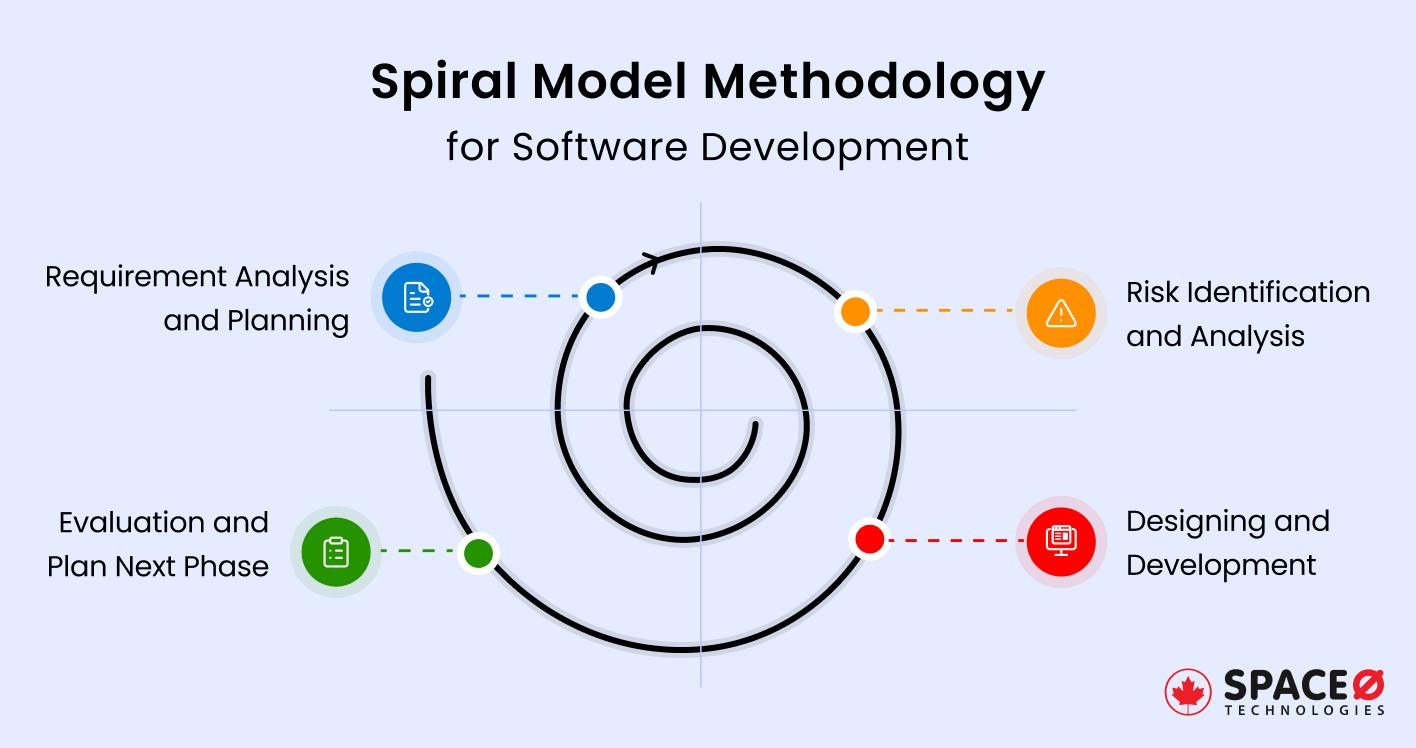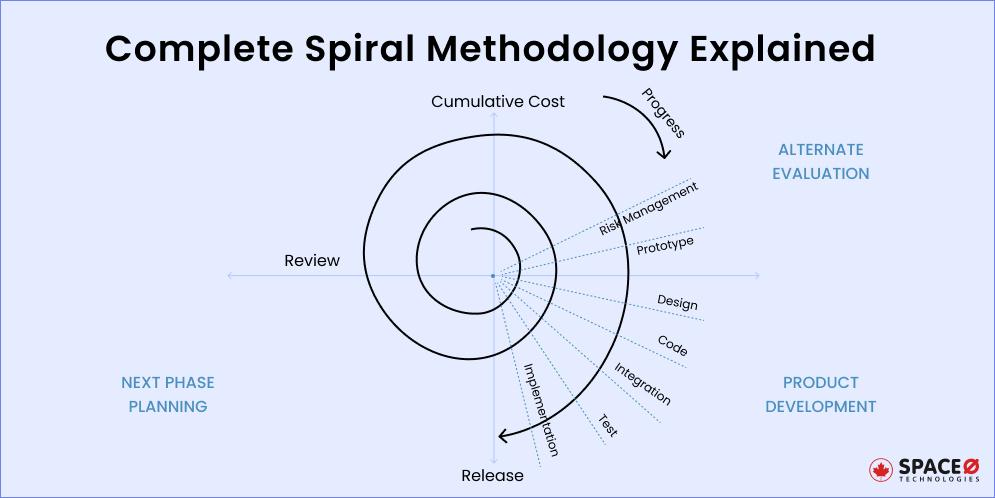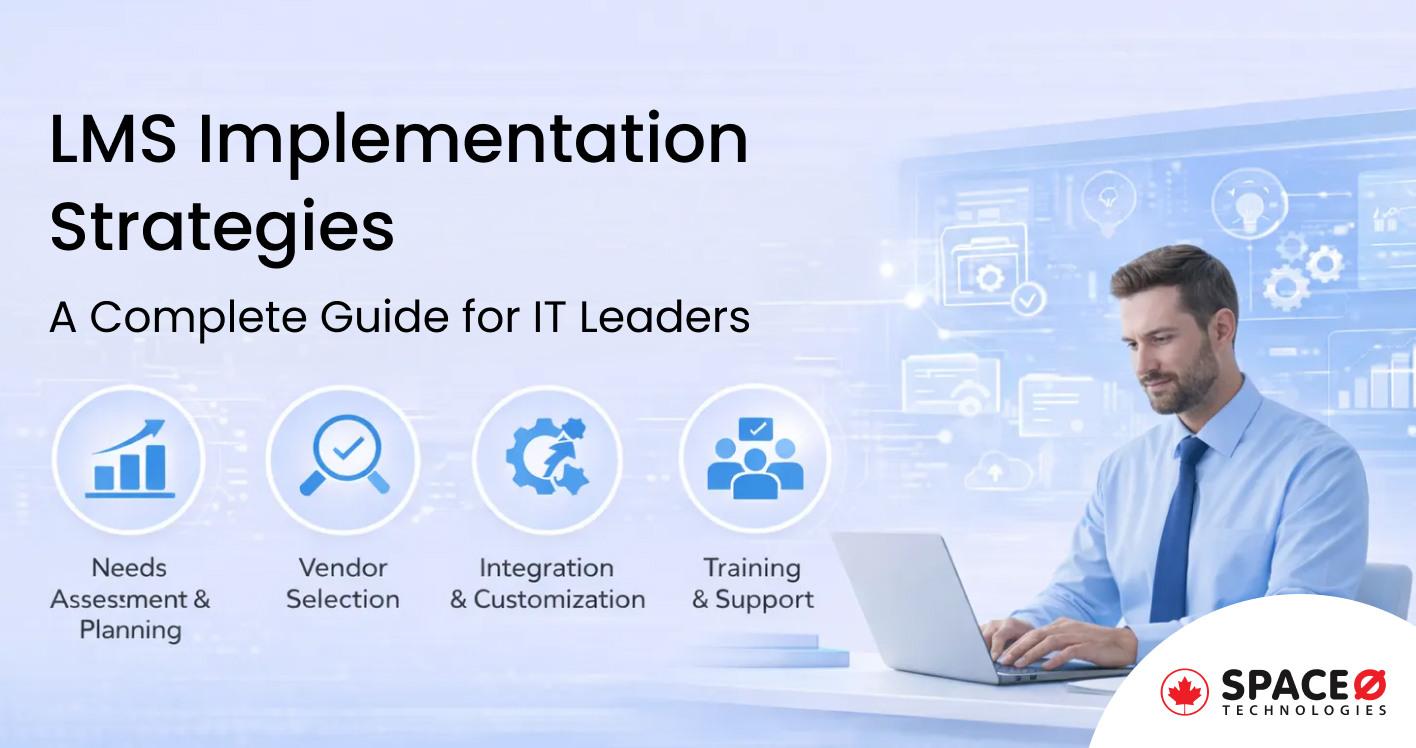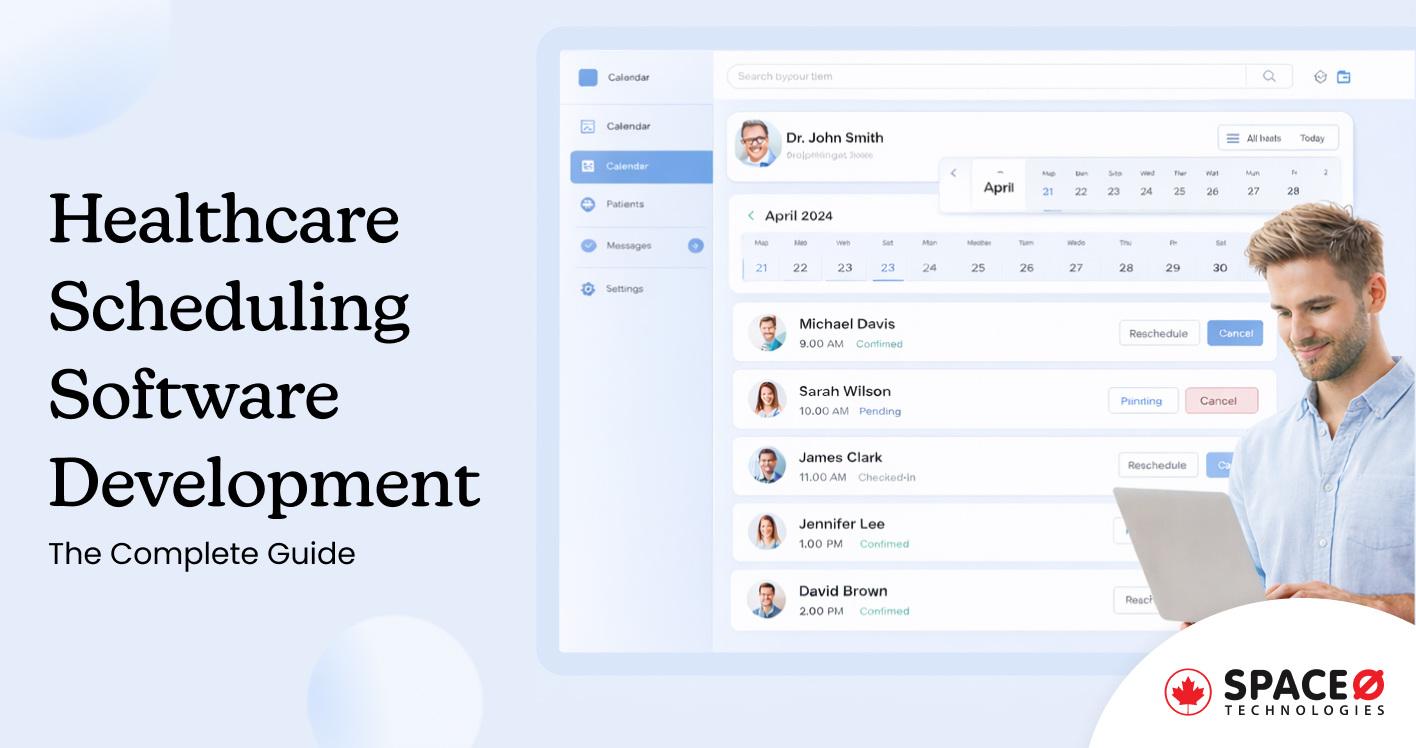
What is Spiral Model of Software Development? [A Complete Process]
Looking to build complex software and want to learn about the spiral model to mitigate risks?
Then read this complete guide where we discussed the spiral model of software development in detail. With this guide, you will get to learn about:
- Software development life cycle (SDLC) of the spiral methodology
- 4 different phases of the spiral model
- Advantages and limitations of using the spiral model for software development
- When to choose spiral model
As a reliable software development company, we have utilized various software methods for developing multiple projects. Also, we have an understanding of different methods which helps us to develop projects successfully. This is the reason we decided to write a dedicated blog post on the explanation spiral model from scratch.
Table of Contents
What is the Spiral Model in Software Development?
The spiral model is a risk-driven software development methodology used to develop large, complex, and high-risk projects. As one of the most important SDLC (Software Development Life Cycle) models, the spiral model combines elements of both iterative and waterfall approaches. This spiral methodology provides continuous risk assessment throughout the development process.
To understand the spiral model, you must know the iterative and waterfall models.
Iterative model – It is a methodology used to start the development of a project with initial requirements, and iteratively enhances the features until the project gets complete. The lean method is a solid example of iterative development which works on similar principles of iterative methodology.
One of the foundational principles of Lean is the idea of continuous improvement that involves regularly evaluating processes, identifying inefficiencies, and then making incremental improvements. Do you want to learn in detail about the lean method? Check our blog post on lean software development methodology.
Waterfall model – It is a development method used to execute project development in a linear and sequential approach. If you are a little bit aware of the Waterfall method, then you would know that each phase starts only once the previous one has been completed. As said in the definition, linear and sequential approaches. However, to understand in detail about the Waterfall method, read our detailed guide on Waterfall software development.
It is a kind of incremental model that focuses on risk analysis, where a software project repeatedly passes through 4 different phases.
Which are the four different phases in the spiral model?
- Step 1. Planning
- Step 2. Risk analysis
- Step 3. Engineering
- Step 4. Evaluation
The baseline spiral is the starting phase where planning is done according to the tailored needs, and risk is assessed. Then, each subsequent spiral is built on the baseline spiral and goes through each development phase to integrate the requirements.
Later, the software development team continue to add functionality in every-increasing spirals until the last production phase.
Check the well-explained image of the spiral model below.

Let’s understand the functioning of the spiral methodology. As a leading software application development company, we have experience in creating complex and larger applications. Based on our experience we have given an easy example to learn why it is an essential part of the software development life cycle.
Suppose you want to add some functionality at the last stages of software project development. At first, you might find it difficult to add new functionality because of the complexity and the ability to bring risks along with it. However, using the spiral software development model, you can make the whole software development process transparent as risk monitoring and regular expertise is its core characteristics.
Now, let’s understand the different phases of the spiral model to find how this spiral model functions.
Want to Develop a Software Solution?
Space-O is a leading software development company in Canada, having experience developing more than 300 software solutions.

What Are the 4 Phases of the Spiral Model?
Each cycle of the spiral model is divided into 4 different quadrants, and the cycle is followed iteratively until the project is completed. In this section, we are discussing the functions of each quadrant.
Requirement Analysis and Planning
Initially, the business needs are gathered from the customers, and objectives are identified in the baseline spiral. Identifying possible alternative solutions is essential if attempted versions fail to perform. It also includes the identification of system, subsystem, and unit requirements through continuous communication between the system analyst and the client.
The requirements analysis and planning stage includes an important document that becomes helpful in the entire software development journey. If you want to learn about the software requirements documentation template, download it below.
 Download
Download
Risk Analysis and Mitigation
Risk analysis is performed to identify, estimate, and monitor any vulnerabilities and defaults in the possible solutions. Also, the risk mitigation strategy is planned and finalized upon confirmation. At the end of the quadrant, a prototype is made for the best possible solution.
Designing and Development of Project
In this step, identified features are developed and go through the testing process. It includes architectural design, design of modules, physical product design, and final design. Finally, the software is built and made available at the end of the third quadrant. To develop scalable and reliable software, you must hire software developers from a reputed development company like Space-O.
Conducting Evaluation and Testing
In the end, test results are evaluated to identify what actually worked and what did not. Also, it includes the planning for the next phase, which begins and the cycle continues.
Advantages of the Spiral Model in Software Engineering
In this section, we are discussing the pros of using the spiral model. We have mentioned the top 4 advantages of the spiral model in detail. Have a look.
Allows You to Handle the Project Risks Effectively
The projects which are complex and large quite bring unknown risks during the software development process. Using the spiral model is the best choice among different software development methodologies because it does risk analysis, risk monitoring, and risk handling at every phase of the development process. The spiral model makes the whole process transparent as you can analyze risks from the beginning to avoid attacks and breakages.
Decrease Risks by Preparing Strategy of Development
It is advised to use the spiral model when the project is large and critical. The spiral model helps the project to divide into several parts to see the risks ahead of the software development process. You create a risk mitigation strategy and actually decrease risk management difficulties. Also, the spiral model has strong approval and documentation control to help you integrate additional functionality later in the process.
Allows You to Evaluate to Increase Customer Satisfaction
The spiral model involves customer feedback. This means the software which is built for the customers can actually evaluate the product in every phase or early stages of the software development process. This model helps developers to save development time and money by making changes beforehand.
Provides Flexibility to Update Build As Per Requirements
It is useful to incorporate requirements accurately at the intermediate phase of the software development process. You view the risks beforehand and devise a risk mitigation strategy to add additional functionalities.
This was all about the cons of the spiral model. Now, let’s discuss the cons of the spiral model.
Disadvantages of the Spiral Model
Each model has its own share of limitations. Therefore, in this section, we will discuss the limitations of the spiral model. Let’s check.
Longer Development Cycle Results in High Cost
The spiral model is expensive as it involves various intermediate stages and requires an experienced software development team that can manage the process.
Increases Dependency as Each Step is Analyzed Before Development
Your project’s success will be highly dependent on the risk analysis phase. Therefore, the involvement of a professional needed who has wide experience in managing complex projects with risk assessments.
Not for Smaller Projects
As it requires a proficient software development team, the spiral model is quite expensive to use. Each phase of the spiral needs special monitoring to identify risks, which makes the whole process more complex. So it increases the cost to develop a software, and thus, it is not suitable for smaller software development projects.
Involves High Complexity Due to Intermediate Phases
High risk is associated with the spiral model as there is little possibility of falling behind schedule or going over budget while integrating additional functionalities. This increases documentation as it involves intermediate phases. Also, you are required to follow a strict protocol when using the spiral model.
After going through the pros and cons of the spiral model, now let’s check various scenarios where you can use the spiral model.
When to Use the Spiral Model
If you are unsure when to use this model, then check the following scenarios where it is advisable to use the spiral model.
- The spiral model in software engineering is used when the project is large, requirements are complex, and you need evaluation to get clarity. For example, you want to create ERP software but you are unsure about the features needed for multiple roles in the software.
- When requirements are unclear or complex, you might need to make significant changes during the software development cycle
- When incremental releases are quite frequent and significant changes are expected from the development process
- When you need customer feedback at each release to mitigate the risks at the early stages of the process during rapid development
Looking to Develop a Custom Enterprise Software?
Share your software development requirements with us. We will validate your idea and offer a custom quote for your project.
If you are still looking for more about the spiral development model, you need to check the following questions that throw some light on this model. Find out the top asked questions by the readers.
FAQs About Spiral Model
What is the risk analysis phase?
In this phase, a process is carried out to identify alternative solutions to mitigate risk and streamline the software development process. A prototype is built at the end of the risk analysis phase to ensure there is no risk found. And if found any, then the development team looks for alternate solutions to implement.
What is risk handling in the spiral model?
The spiral model is known for handling unknown risks that occur after the development process is started and might affect the successful completion of software. These risks are easily managed by developing a prototype at every phase of the software development.
What is the spiral model in software engineering?
The spiral model in software engineering is a risk-driven development process that combines iterative development with systematic aspects of the waterfall model.
What are the 4 phases of the spiral model?
The 4 phases of the spiral model are: (1) Planning, (2) Risk Analysis, (3) Engineering, and (4) Evaluation.
When should you use the spiral model?
Use the spiral model when your project has high risk factors, requirements are complex or unclear, and you need frequent customer feedback.
Let’s Develop Your Enterprise Software
We hope this guide has helped to learn about the spiral model in detail. Now, it will be easy for you to choose this model in the most relevant scenario. You have learned four phases of the spiral model, the pros and cons of this model, along with the conditions when you use it.
In case you still have doubts or are not sure whether you should use the spiral model for your project or not, contact us with your requirements. Being a top software development company, we will help to build software with the best process model.

Want to Develop a Custom Software Solution?
Editor's Choice

LMS Implementation Strategies: A Complete Guide for IT Leaders

How to Build an eLearning Platform: A Complete Guide for 2026

Healthcare Scheduling Software Development: The Complete Guide for 2026
All our projects are secured by NDA
100% Secure. Zero Spam
*All your data will remain strictly confidential.
Trusted by


Bashar Anabtawi
Canada
“I was mostly happy with the high level of experience and professionalism of the various teams that worked on my project. Not only they clearly understood my exact technical requirements but even suggested better ways in doing them. The Communication tools that were used were excellent and easy. And finally and most importantly, the interaction, follow up and support from the top management was great. Space-O not delivered a high quality product but exceeded my expectations! I would definitely hire them again for future jobs!”

Canada Office
2 County Court Blvd., Suite 400,
Brampton, Ontario L6W 3W8
Phone: +1 (437) 488-7337
Email: sales@spaceo.ca

